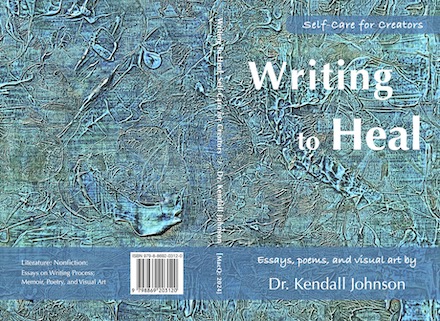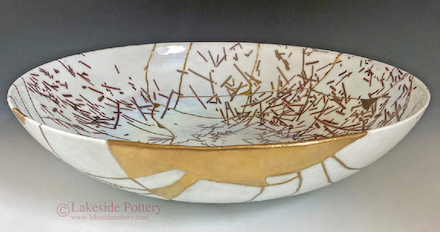
|
|
|
|
|
| Issue 23: | 28 April 2024 |
Curated by Clare MacQueen
Now in Print From MacQ
Writing to Heal: Self-Care for Creators by Kendall Johnson
(includes 21 full-color artworks)

Full cover of Writing to Heal (published by MacQ on 1 May 2024);
click image for enlarged view.
Cover art: Untitled painting, 2022 (M-15, Melting Into Air Series) by
Kendall Johnson. Copyrighted © by the artist. All rights reserved.
I’ve been broken by the world, I’ll admit. Stronger now at some of my broken places, yet scarred in many ways.... As teacher, trauma therapist, and on-scene crisis consultant, my icon—my guiding hope—has been the kintsugi image: a broken ceramic bowl with the parts glued back together, the scars and seams shining with resin and gold. Writing and art have been my salvation.
—Kendall Johnson, in “Tapping Hidden Gifts of Experience” (Writing to Heal, Part I)

Broken bowl restored via Kintsugi process by Morty Bachar,
Lakeside Pottery Studios | https://lakesidepottery.com/
Copyrighted © by Morty Bachar and Lakeside Pottery Studios.
All rights reserved. Image appears here with artist’s permission.
Praise for Writing to Heal: Self-Care for Creators
This beautifully written and resonant book is a legacy of the heart, from its author to all those who create, be it through the written word, visual arts, movement, or music.... With Johnson’s own artworks interwoven through most of these essays, Writing to Heal gives us a richly illuminating tapestry of words and images.
—From the publisher’s introduction
How grateful I am for Kendall Johnson’s “Through a Curatorial Eye: The Apocalypse This Time” [Part IV of Writing to Heal, first published online in MacQ-19]. What an amazing piece this is—beautifully clear writing throughout and an innovative approach, all in the service of a kind of wisdom sorely needed in the world now. As I read through it I said to myself—this is not just good, it’s what greatness is. It’s that gift we long for that tears into you and won’t let go.
—Daryl Scroggins, writer of fiction, creative nonfiction, prose and lineated poetry, and the author of This Is Not the Way We Came In (flash fictions and a flash novel)
“Writing and art have been my salvation,” says Dr. Kendall Johnson, and he took the words right out of my mouth. We look for ways to navigate and live with the complexities and agonies of life without being blind to its mystery and magic. Johnson shows us how to use creative gifts to process, express, connect, survive, and thrive. Blending lived experience of trauma, professional expertise, and a passion for poetry and painting, this unique, beautiful collection will touch countless lives.
—Lorette C. Luzajic, founding editor of The Ekphrastic Review and The Mackinaw
Introduction by Clare MacQueen in Writing to Heal
His is an incredibly empathetic heart and calm voice that comes
back from the depths of things not to show his battle scars,
but to show that there is indeed a path out of
the most sorrowful and hopeless of places.
—Dennis Callaci1
A confession upfront: I’m an unabashed admirer of Kendall Johnson, the writer, the artist, the exceptional human being. I see him as surprisingly joyful and optimistic, despite the battle scars mentioned in the quotation above, and he’s among my heroes and role models. It has been my pleasure and privilege to publish Dr. Johnson’s writing and visual art—essays, poems, paintings, and photographs—in MacQueen’s Quinterly online. And now, I’m deeply honored to present this full-length, printed collection of three dozen of his works, Writing to Heal: Self-Care for Creators.
This beautifully written and resonant book is a legacy of the heart, from its author to all those who create, be it through the written word, visual arts, movement, or music.
With insights gleaned from decades of work as a firefighter, trauma therapist, and crisis consultant, Dr. Johnson weaves his own personal experiences into Writing to Heal in various forms: creative nonfiction, ekphrasis, epistolary, journal entries, memoir, poems, poetic hybrids, and paintings. To illustrate two of his major projects, Ground Zero and Incendiaries, he uses specific examples as he lays out his process for creating words and art that “glow,” that illuminate the darkness.
His description of strategies that work for him are not pedantic or preachy, but are user-friendly and always accessible. Not to mention fascinating. And he provides practical ways to “help you write your way through difficult material.”
Which I believe are especially useful for culture-makers and creators like writers, artists, dancers, and musicians, who want to mine their own personal experiences to enliven their work—yet find themselves stymied, or even blocked, by “unbearable interior fireworks.” In his Part II essay, “Diving Deep,” Dr. Johnson encapsulates a simplified technical discussion of triggers, including how and why we react to them. And he presents numerous suggestions, along with visual aids, to manage our responses in ways that can help us mitigate further pain or injury, and move forward with our work.
In Part IV, “Through a Curatorial Eye: The Apocalypse This Time,” Johnson talks about the dominant myth with which he was raised during the 1950s, as well as modernist aesthetics and paintings by Pollock, Joan Mitchell, and Rothko. This marvelous essay so impressed the writer Daryl Scroggins (also among my favorite folks) that he concluded: “This is not just good, it’s what greatness is.”2
Of course I said, Amen, and in November 2023, was delighted to nominate “Through a Curatorial Eye” for the Pushcart Prize.
In the final two essays, Johnson calls for us to use the skills we’ve learned for important work, as forces for good, and again proffers several specific suggestions, with the goal of creating works in such a way that they “glow in the dark.” Yet without causing harm to ourselves and others. We in turn become light-emanating guides, showing others a path out of sorrow and hopelessness, thus encouraging them to nurture their own light as well.
Elsewhere in this book, the author discusses projects and processes by poets John Brantingham, Tony Barnstone, and Joy Ladin, as well as works by artists Matisse, Father Bill Moore, and Van Gogh. With Johnson’s own artworks interwoven through most of these essays, Writing to Heal gives us a richly illuminating tapestry of words and images.
As Kate Flannery says, “If anyone can find a spark of light in the darkness, it’s Kendall Johnson.”3
With all my heart, I agree. And I offer my profound appreciation: Thank you, Kendall, for sharing your “best light” with the world.
Links were retrieved in February 2024 [and re-confirmed on 25 April 2024].
- From an interview by author, songwriter, and musician Dennis Callaci, “Kendall Johnson’s Black Box Poetics Is Out Today on Bamboo Dart Press,” in the Shrimper Records blog (10 June 2021):
http://www.shrimperrecords.com/kendall-johnsons-black-box-poetics-is-out-today/ - From the blurb by Daryl Scroggins inside the front cover of this book. Scroggins is the author of This Is Not the Way We Came In (flash fictions and a flash novel), and his fictions, creative nonfictions, prose poems, and line poems have appeared in numerous publications over the years.
- From “The World Needs More Fireflies” by writer, lawyer, and musician Kate Flannery in The Journal of Radical Wonder (5 May 2022):
https://medium.com/the-journal-of-radical-wonder/the-world-needs-more-fireflies-3b3dfd9e0e19
Morty Bachar
has an extensive background in engineering and product design. Also an accomplished ceramic artist, ceramic instructor, and art restorer, he performs ceramic and sculpture repair and restoration for individuals, collectors, dealers, and museums. In addition, he designs and creates custom pottery work on commission and to further his passion for Kintsugi art.
The U.S. Department of State has commissioned Bachar to create Kintsugi art: first, for President Joe Biden to present to Japanese Prime Minister Yoshihide Suga during his April 2021 visit to the White House; and second, to create a special piece to present to Japanese Prime Minister Fumio Kishida during his April 2024 visit to the White House. [For details, see links in the section below, More on the Web...]
Morty Bachar and his wife, Patty Storms, also a ceramic artist, painter, and sculptor, own and manage Lakeside Pottery Studio, which they established in 2001 in Stamford, CT and then relocated to Lewes, DE in 2015. They combine their many years of experience in teaching art, pottery, sculpting, engineering, and painting, to operate their studios: https://www.lakesidepottery.com/
More on the Web: By, About, and Beyond
⚡ Lewes artist visits White House: “Morty Bachar creates piece for Japanese prime minister” by Ryan Mavity in Cape Gazette (19 April 2024).
See also this video with highlights of the creation process: 2 Lbs of Clay’s Journey to the White House
⚡ Lewes artist creates presidential gift for Japanese prime minister in Cape Gazette (21 April 2021). As the artist was quoted:
“I am delighted to see the Kintsugi metaphor now part of international affairs as a symbol of renewal and healing.... Kintsugi gives new life or rebirth to damaged or aging ceramic objects by celebrating their flaws and history. One can consider how we might live a kintsugi life, finding value in the missing pieces, cracks, and chips; bringing to light the scars that have come from life experiences; finding new purpose and meaning through aging and loss; seeing love and the beauty of imperfection; and loving ourselves, family, friends, and country, even with flaws.”
⚡ Making Missing Segments From Clay and Resin Methods For Gold Kintsugi Art Repair Applications, a short video with highlights of Morty Bachar restoring the lovely bowl that’s pictured at the beginning of this webpage.
| Copyright © 2019-2025 by MacQueen’s Quinterly and by those whose works appear here. | |
| Logo and website designed and built by Clare MacQueen; copyrighted © 2019-2025. | |
|
Data collection, storage, assimilation, or interpretation of this publication, in whole or in part, for the purpose of AI training are expressly forbidden, no exceptions. |
At MacQ, we take your privacy seriously. We do not collect, sell, rent, or exchange your name and email address, or any other information about you, to third parties for marketing purposes. When you contact us, we will use your name and email address only in order to respond to your questions, comments, etc.